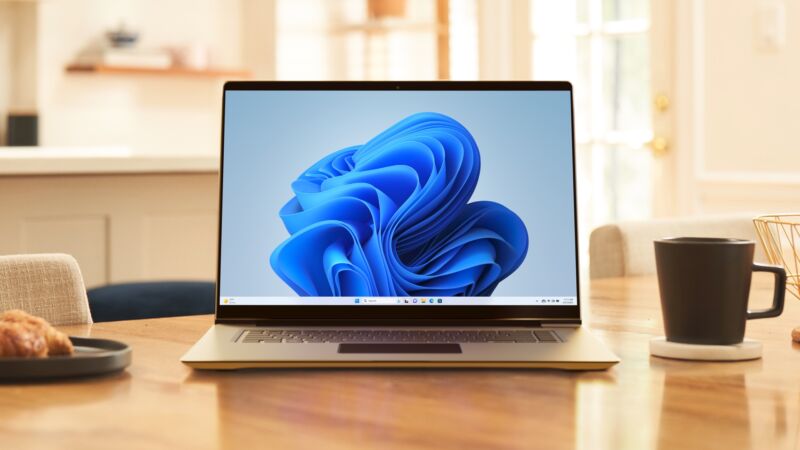
As we’ve written before, Windows 11’s adoption among PC users has been a bit slower than Windows 10’s, and that has continued into the operating system’s second year. Internal Microsoft data obtained by Windows Central claims that Windows 11 is currently in use on around 400 million PCs, almost exactly two years after the operating system’s October 2021 release.
Windows 10 had been installed on over 500 million systems by its second birthday, which backs up data we’ve seen from sources like Statcounter and the Steam Hardware Survey—Windows 11 just isn’t being adopted at the same rate as its predecessor. Worldwide Windows market share data from Statcounter suggests that Windows 11 runs on between 23 and 24 percent of Windows PCs, compared to 72 percent for Windows 10, and Statcounter shows Windows 11’s growth has stagnated in recent months. Still, Windows 11’s numbers are said to surpass Microsoft’s internal expectations.
It’s difficult to directly compare Windows 10’s adoption rate and Windows 11’s. Windows 10 was explicitly intended to run on any system that could already run Windows 7 and Windows 8, the two most popular versions of the operating system at the time of its release. Microsoft also offered it to those users as a free upgrade for one year, a then-unprecedented move meant to spur people to upgrade their existing PCs rather than wait to get Windows 10 on a new one. By contrast, Windows 11’s system requirements generally limit it to PCs released in or after late 2017 and 2018, cutting off a large number of PCs that are running Windows 10 just fine.
A better comparison point might be Windows 7. Windows 7 was mainly trying to replace Windows XP, a popular and entrenched version of the operating system with lower system requirements. Windows 7 was released in October 2009, and by October 2011, it was running on nearly 45 percent of all Windows PCs worldwide, overtaking Windows XP as the most popular version.
Windows 7 adoption numbers still don’t make for a perfect comparison to Windows 11. Windows 7 brought major technical improvements to XP (though most had already been present in the less-popular Windows Vista), whereas Windows 11’s are mostly cosmetic. And in the late 2000s and early 2010s, PC hardware was still evolving fast enough that buying a new computer every few years still got you noticeable speed increases. Windows 7 was also a version that upgraders needed to pay for, where Windows 11 was free for (compatible) Windows 10 PCs.
The upshot is that Windows 11 seems to be doing a bit better than Windows Vista and Windows 8, remembered in the popular imagination as “bad” versions of Windows. Those releases both crested at about 25 percent of worldwide Windows usage in the three years between their release and replacement, a mark that Windows 11 is already close to hitting after two years. But Windows 11’s growth still looks like it stalled out faster than Windows 7’s or Windows 10’s did.
Windows 10’s security update cliff
It’s difficult to know how many active PCs are incapable of installing Windows 11. An October 2023 report from IT asset-management company Lansweeper suggests that, of 33 million Windows PCs tracked by Lansweeper, about a third are ineligible. This is mostly because they don’t meet the operating system’s CPU requirements, generally an 8th-gen Intel Core/AMD Ryzen 2000 CPU or newer—most PCs that meet the CPU requirement will also meet Windows 11’s RAM, storage, and Trusted Platform Module (TPM) requirements.
The number of incompatible PCs is probably a bit higher among the general public since IT firms often replace systems more aggressively in the name of preventative maintenance.
That number will decrease between now and the scheduled end of Windows 10 security updates in October 2025 as more old systems break and/or are replaced. But at this rate, that could still leave hundreds of millions of Windows 10 PCs unprotected.
This always happens after Microsoft’s update cutoffs; Windows 7, 8, and even XP still collectively claim 4 or 5 percent of worldwide Windows usage share between them, though security updates have long since ceased. But if Windows 10 usage remains stubbornly high, Microsoft may need to extend the operating system’s update lifecycle to prevent widespread problems.
There’s precedent for this. Microsoft offered businesses and other organizations an extra three years of paid Windows 7 security updates, even after most home users stopped getting them, and the company provided similar paid support for Windows XP for the US government. Microsoft also extended the security update timelines for consumer operating systems like Windows XP and Windows 98 after they proved stubbornly popular. We’ll see if Microsoft does something similar for Windows 10—or if the rumored Windows 12 release next year offers another support off-ramp for all of these older-but-still-functional PCs.
https://arstechnica.com/?p=1976808

